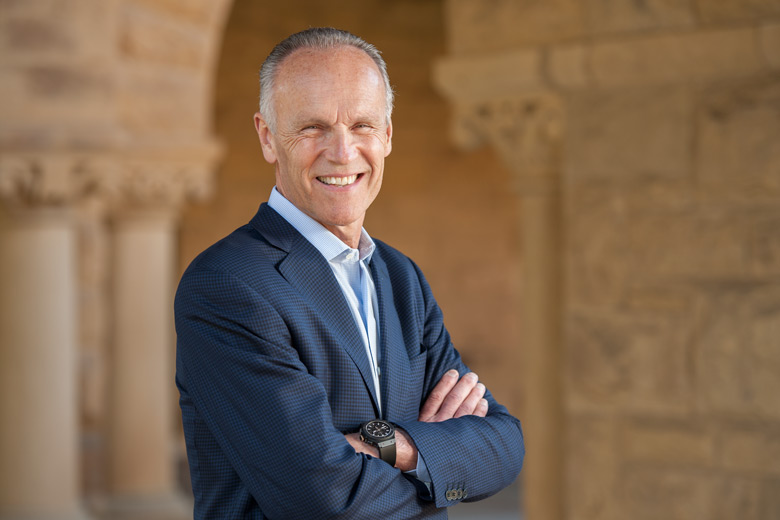Stanford trustees address construction projects and university budget
During its June meeting, members of the Stanford University Board of Trustees reviewed construction projects, including the new Denning House, approved the university budget and feted outgoing President John Hennessy and his wife, Andrea.
Plans for Denning House, the new home of the Knight-Hennessy Scholars program, are moving forward thanks to concept and site approval by the Stanford Board of Trustees this week.
Denning House, which will be located near Lake Lagunita and next to Roble Hall, has been made possible by a gift from trustee Chair Steven Denning and his wife, Roberta. The site is currently a gravel parking lot located off Lomita Drive.

At its June meeting, the Stanford Board of Trustees gave concept and site approval for Denning House, new home of the Knight-Hennessy Scholars program. The building has been made possible by a gift from trustee Chair Steven Denning (above) and his wife, Roberta. (Image credit: L.A. Cicero)
The two-story building will house the administrative staff of the new Knight-Hennessy Scholars program, as well as meeting and dining spaces for the high-achieving graduate students from throughout the world admitted to the program. Also featured will be multi-purpose lecture spaces and discussion rooms. The building will offer views of Lake Lagunita and the foothills. Its building materials will complement the residential buildings in the area.
Denning hopes the approximately 20,000-square-foot building will become an “interaction hub” for Knight-Hennessy Scholars, who he believes will “further globalize Stanford from the inside out.”
At its meeting, the board also approved the 2016-17 university budget – a budget Denning called “appropriately prudent and cautious.”
Denning said the board used budget discussions to acknowledge the stewardship of Provost John Etchemendy, who will be stepping down. As provost, Etchemendy is the university’s chief budget officer, as well as its chief academic officer, and Denning praised Etchemendy for keeping the university healthy and fiscally sound. He also praised the partnership President John Hennessy and Etchemendy created and credited it with the “preeminence” Stanford has achieved.
Denning noted that the single largest allocation of new funding in the upcoming budget will be for sexual assault support, education and adjudication. About $2.7 million has been allocated for new programs and additional staff as a reflection for concern about the welfare of the university community.
That allocation reflects what Denning called a “real awareness” among board members of the resources needed to address issues of sexual assault. He added, “We are all interested in doing whatever we can can to address cultural change.”
Financial aid was also a high priority for the board, Denning said, calling ensuring access to a Stanford education “inviolate.” Stanford will provide $286 million in direct financial aid to students in the coming year – a 3.8 percent increase.
Denning said the trustees also took the opportunity during their meeting to honor Hennessy and his wife, Andrea, for their 16 years of service to Stanford. The board specifically noted Hennessy’s commitment to access and financial aid, leadership through the recession, vision of a unified university, expansion of Stanford’s global impact, emphasis on interdisciplinary research and teaching, commitment to sustainability and transformation of the arts on campus. Denning also noted Andrea Hennessy’s important role in the enhancement of arts facilities and programs on campus.
“The two of them together were really the power behind the arts district,” Denning said. The board presented the two with a work by Richard Diebenkorn titled Touched Red.
The trustees also heard from Stanford faculty as part of what Denning called “an attempt to educate trustees in the rich research and capabilities around the university.” The presentations focused on:
- Interdisciplinary education, which was given by Dan McFarland, professor of education and of organizational behavior, who talked about the productivity that has resulted from the enhancement of interdisciplinary institutes at Stanford. Denning said McFarland’s presentation reinforced the efficacy of the vision Hennessy had in encouraging interdisciplinary teaching and research.
- Intellectual property law and policy, a presentation that featured faculty experts from Stanford Law School. Faculty members Mark Lemley, Paul Goldstein and Lisa Larrimore Ouellette, as well as Law School Dean Elizabeth Magill, gave the board an explanation of patent law and the evolution of technology transfer in colleges and universities.
- Social and education inequality, which featured education Professor Sean Reardon. Reardon is an expert in poverty and inequality in education who shared his research, which relied on large data bases, with trustees. In his most recent research, Reardon and his colleagues reviewed more than 200 million test scores to spotlight communities with the nation’s worst achievement gaps.
The board also discussed construction projects, including the 2,400-bed graduate housing complex in Escondido Village. Ground is expected to be broken on that project next year. Also anticipated in the coming academic year is the opening of the first units available in the new faculty housing development at University Terrace.
The board gave construction approval for:
- The Anne T. and Robert M. Bass Biology Research Building, which will provide laboratory research space for about half of the department’s faculty, staff and technicians. Planned as a four-story building – with three above ground and one below – it is projected to be completed in late 2018.
- The Kingscote Gardens renovation, which is converting the former apartments into space for student support programs, including counseling, diversity and Americans with Disabilities Act compliance. Constructed in 1917, the building is expected to be remodeled by August 2017.
- The renovation of the Schwab Residential Center, which houses graduate business students. The renovation, including upgrades to kitchens and bathrooms, will be completed in September 2017 and will make Schwab as attractive a housing option as the new Highland Hall.
